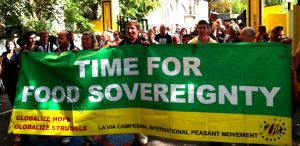Instead of posturing to look like he supports farmers, the president should be pushing for reforms in agricultural programs that would actually help the little guy
By: Jim Goodman, President, National Family Farm Coalition (Wonewoc, WI)
Published by the Daily Yonder, Aug. 2nd, 2018
Despite strong continued support for President Trump in rural America, farmers fear they will bear the brunt of the retaliatory tariffs from the president’s trade war.
Farm country can ill afford it: In February, the U.S. Department of Agriculture (USDA) predicted 2018 crop profits would hit a 12 year low. Dairy farmers’ prices have fallen 30% in two years, while pork producers have seen a price drop of roughly $20 per head. Overall farm incomes are down nearly 50% from 2013. Long before the trade war began, I and many other farmers feared we were in a farm crisis as bad as that of the 1980s. Now we know it will be even worse.

While the president has said he could “stand in the middle of Fifth Avenue and shoot somebody” and not lose support, he also knows who butters his bread. And so, we have a new $12 billion emergency aid package for farmers to ease the sting of the tariffs, clearly designed to keep his rural base firmly behind him. But will it actually solve farmers’ problems? I doubt it.
Twelve billion dollars is a lot of money, but spread across all the major agricultural commodities, it will be a drop in the bucket. Details on how the money will be dispersed are still hazy, but I suspect most of it will not find its way into the pockets of struggling farmers.
The proposed scheme divides the funds into three pots. One will be used for direct incremental payments to producers of soybeans, sorghum, corn, wheat, cotton, dairy and hogs, for losses sustained from the tariffs. A second will use USDA Commodity Credit Corporation (CCC) authority to purchase commodities of fruits, nuts, rice, legumes, beef, pork and milk and distribute them to food banks. The third will use CCC funds to partner with the private sector to develop new export markets for agricultural commodities.
So what’s wrong with that? Well, plenty. First, direct payments will supposedly replace projected income lost due to the tariffs – as if everything was going along fine in farm country before the president’s little trade war. The whole plan ignores the full-blown farm crisis – complete with farmers struggling to pay their electric bills and buy food, forced to sell their farms, and in some cases taking their own lives – that has been quietly growing in the countryside for years, with virtually no recognition or corrective action from Washington. But now they’re playing politics.
Second, after the bailout gives an unknown share of $12 billion to make up for farmers’ low prices and feed the working poor through a donation program, it hands the rest to big agribusiness for export market development. Farmers are already forced to pay a tax on every animal or bushel of grain we sell. This checkoff goes to agribusiness trade groups for product promotion and market development. But apparently that’s not enough, so this deal gives them another pound of flesh – this time from the taxpayers.
The real problem facing farm country is not international tariffs. It is that we produce too much. Farmers are told that to survive, we must produce every possible bushel, every gallon of milk or pound of meat, no matter what it costs to buy the inputs, no matter the toll on the environment. When prices are low, we must produce more – and of course that means even lower prices and a never-ending death spiral.
The small farms go first in hard times; the land merged into bigger operations, and the small dairy herds, like mine, sold off. My state of Wisconsin is losing 1.5 dairy farms every day – that’s 1.5 farmers out of a job. We can only guess at the economic impact the loss of these small farms will have on the businesses in their rural communities.
There is another way: not a bailout, but a minimum wage. For many years, federal farm policy included a grain reserve. The government bought grain in times of low prices, sold it back into the market when supplies were low, and ensured farmers a floor price to keep them farming at a profit rather than producing below their cost of production. This stabilized the food supply and food prices, and farmers were required to maintain good environmental practices – no fence-row to fence-row planting.
We could do the same for livestock producers. Rather than forever chasing new export markets, we could, like Canada, simply keep our production in line with domestic consumption. Canada’s supply management program guarantees farmers a fair price and guarantees consumers adequate food supplies grown locally – with no taxpayer subsidies required. We could still export excess production where there was demand, but US farmers would no longer compete with every farmer in the world over who can produce the cheapest product. Farmers, like everyone else, do better with a fair price for their work rather than emergency handouts.
Trump’s trade war will cause irreparable damage to the farm sector, but we were bleeding long before he took to Twitter. If the president really wants to help farmers – and consumers, the environment, and taxpayers – he would lobby for a U.S. supply management program, not a $12 billion PR stunt.



